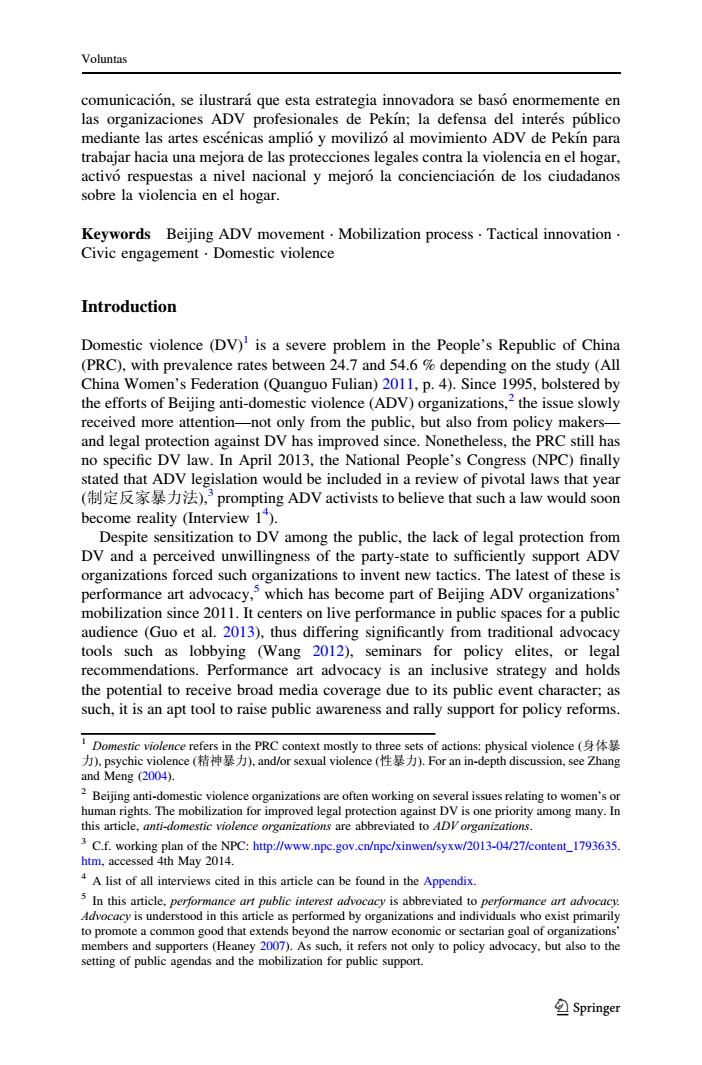正在加载图片...

Voluntas comunicacion,se ilustrara que esta estrategia innovadora se baso enormemente en las organizaciones ADV profesionales de Pekin;la defensa del interes publico mediante las artes escenicas amplio y movilizo al movimiento ADV de Pekin para trabajar hacia una mejora de las protecciones legales contra la violencia en el hogar, activo respuestas a nivel nacional y mejoro la concienciacion de los ciudadanos sobre la violencia en el hogar. Keywords Beijing ADV movement.Mobilization process.Tactical innovation. Civic engagement.Domestic violence Introduction Domestic violence (DV)is a severe problem in the People's Republic of China (PRC),with prevalence rates between 24.7 and 54.6%depending on the study (All China Women's Federation(Quanguo Fulian)2011,p.4).Since 1995,bolstered by the efforts of Beijing anti-domestic violence (ADV)organizations,the issue slowly received more attention-not only from the public,but also from policy makers- and legal protection against DV has improved since.Nonetheless,the PRC still has no specific DV law.In April 2013,the National People's Congress (NPC)finally stated that ADV legislation would be included in a review of pivotal laws that year (制定反家暴力法),3 prompting ADV activists to believe that such a law would soon become reality (Interview 1). Despite sensitization to DV among the public,the lack of legal protection from DV and a perceived unwillingness of the party-state to sufficiently support ADV organizations forced such organizations to invent new tactics.The latest of these is performance art advocacy,which has become part of Beijing ADV organizations' mobilization since 2011.It centers on live performance in public spaces for a public audience (Guo et al.2013),thus differing significantly from traditional advocacy tools such as lobbying (Wang 2012),seminars for policy elites,or legal recommendations.Performance art advocacy is an inclusive strategy and holds the potential to receive broad media coverage due to its public event character;as such,it is an apt tool to raise public awareness and rally support for policy reforms. Domestic violence refers in the PRC context mostly to three sets of actions:physical violence 力),psychic violence(精神暴力),and/or sexual violence(性暴力).For an in-depth discussion,.see Zhang and Meng (2004). 2 Beijing anti-domestic violence organizations are often working on several issues relating to women's or human rights.The mobilization for improved legal protection against DV is one priority among many.In this article,anti-domestic violence organizations are abbreviated to ADV organizations. 3 C.f.working plan of the NPC:http://www.npe.gov.cn/npc/xinwen/syxw/2013-04/27/content_1793635. htm,accessed 4th May 2014. 4 A list of all interviews cited in this article can be found in the Appendix. 5 In this article,performance art public interest advocacy is abbreviated to performance art advocacy. Advocacy is understood in this article as performed by organizations and individuals who exist primarily to promote a common good that extends beyond the narrow economic or sectarian goal of organizations' members and supporters(Heaney 2007).As such,it refers not only to policy advocacy,but also to the setting of public agendas and the mobilization for public support. ②Springercomunicacio´n, se ilustrara´ que esta estrategia innovadora se baso´ enormemente en las organizaciones ADV profesionales de Pekı´n; la defensa del intere´s pu´blico mediante las artes esce´nicas amplio´ y movilizo´ al movimiento ADV de Pekı´n para trabajar hacia una mejora de las protecciones legales contra la violencia en el hogar, activo´ respuestas a nivel nacional y mejoro´ la concienciacio´n de los ciudadanos sobre la violencia en el hogar. Keywords Beijing ADV movement · Mobilization process · Tactical innovation · Civic engagement · Domestic violence Introduction Domestic violence (DV)1 is a severe problem in the People’s Republic of China (PRC), with prevalence rates between 24.7 and 54.6 % depending on the study (All China Women’s Federation (Quanguo Fulian) 2011, p. 4). Since 1995, bolstered by the efforts of Beijing anti-domestic violence (ADV) organizations,2 the issue slowly received more attention—not only from the public, but also from policy makers— and legal protection against DV has improved since. Nonetheless, the PRC still has no specific DV law. In April 2013, the National People’s Congress (NPC) finally stated that ADV legislation would be included in a review of pivotal laws that year (制定反家暴力法),3 prompting ADV activists to believe that such a law would soon become reality (Interview 14 ). Despite sensitization to DV among the public, the lack of legal protection from DV and a perceived unwillingness of the party-state to sufficiently support ADV organizations forced such organizations to invent new tactics. The latest of these is performance art advocacy,5 which has become part of Beijing ADV organizations’ mobilization since 2011. It centers on live performance in public spaces for a public audience (Guo et al. 2013), thus differing significantly from traditional advocacy tools such as lobbying (Wang 2012), seminars for policy elites, or legal recommendations. Performance art advocacy is an inclusive strategy and holds the potential to receive broad media coverage due to its public event character; as such, it is an apt tool to raise public awareness and rally support for policy reforms. 1 Domestic violence refers in the PRC context mostly to three sets of actions: physical violence (身体暴 力), psychic violence (精神暴力), and/or sexual violence (性暴力). For an in-depth discussion, see Zhang and Meng (2004). 2 Beijing anti-domestic violence organizations are often working on several issues relating to women’s or human rights. The mobilization for improved legal protection against DV is one priority among many. In this article, anti-domestic violence organizations are abbreviated to ADV organizations. 3 C.f. working plan of the NPC: http://www.npc.gov.cn/npc/xinwen/syxw/2013-04/27/content_1793635. htm, accessed 4th May 2014. 4 A list of all interviews cited in this article can be found in the Appendix. 5 In this article, performance art public interest advocacy is abbreviated to performance art advocacy. Advocacy is understood in this article as performed by organizations and individuals who exist primarily to promote a common good that extends beyond the narrow economic or sectarian goal of organizations’ members and supporters (Heaney 2007). As such, it refers not only to policy advocacy, but also to the setting of public agendas and the mobilization for public support. Voluntas 123